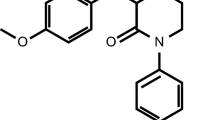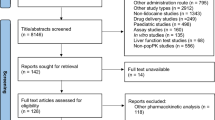Summary
As only insufficient knowledge about the dosage of teicoplanin in hemodialysis patients exists, a clinical trial was performed on 26 patients. An initial dose of 800 mg teicoplanin, followed by doses of 400 mg on day 8 and day 15, was administered. In addition to the common clinical parameters (fever, white blood cell count, C-reactive protein), the plasma concentrations of this substance were determined. The HLTterm was 159±35 h, the Vss 104±25 l/100 kg and the CLtot 5.3±1.3 ml/min. It could be shown that the dosage regimen mentioned above produced long-lasting and highly effective levels, sufficiently surpassing the MICs of the expected bacteria (streptococci and staphylococci). The easily administered substance showed no adverse side effects, based on clinical criteria. The above-mentioned therapy nearly always resulted in success according to clinical criteria. Therefore, and due to its easy administration, it seems advantageous to start treatment with teicoplanin in hemodialysis patients obviously suffering from bacterial infections.
Zusammenfassung
Da bisher nur unzureichende Daten über die Dosierung von Teicoplanin bei Hämodialysepatienten vorlagen, wurde eine Studie mit 26 Patienten durchgeführt. Die Patienten erhielten initial 800 mg Teicoplanin i.v. und dann jeweils 400 mg am 8. und 15. Tag. Neben den üblichen klinischen Parametern (Fieber, CRP, Leukocyten) wurden die Plasmaspiegel bestimmt. Die terminale Halbwertzeit betrug 159±35 h, das Verteilungsvolumen 104±25 l/100 kg und die totale Clearance 5,3±1,3 ml/min. Es zeigte sich, daß unter dieser Medikation lang- und hochwirksame Spiegel vorlagen, die weit über der minimalen Hemmkonzentration von Zielkeimen (Streptokokken und Staphylokokken) liegen. Die bequem zu applizierende Medikation wurde gut vertragen. Die Form der Behandlung führte nach klinischen Kriterien fast stets zum Erfolg. Aus diesen Gründen und wegen der einfachen Applikationsart erscheint es angebracht, bei Dialysepatienten, die offensichtlich an bakteriellen Infektionen erkrankt sind, die Therapie mit Teicoplanin einzuleiten.
Similar content being viewed by others
References
Neu, H. C., Lasthavikul, P. In vitro activity of teichomycin compared with those of other antibiotics. Antimicrob. Agents Chemother. 24 (1983) 425–428.
Bonati, M., Traina, G. L., Rosina, R., Buniva, G. Pharmacokinetics of a single intravenous dose of teicoplanin in subjects with various degrees of renal impairment. J. Antimicrob. Chemother. 21 (1988) (Suppl. A 29) 29–37.
Muth, P., Kinzig, M., Lang, E., Birner, B., Sörgel, F.: Experience with an HPLC-gradient elution method for the determination of teicoplanin in blood samples from patients of intensive care units. Abstract No. 825 (p. 182) of the 7th Mediterranean Congress of Chemotherapy, 20–25 May 1990, Barcelona, Spain.
Varaldo, P., Debbias, E., Schito, G. C. In vitro activity of teichomycin and vancomycin alone and in combination with rifampin. Antimicrob. Agents Chemother. 24 (1983) 402–406.
Grimm, H. Die mikrobiologische Testung von Teicoplanin. RAC (Referate zur antimikrobiellen und neoplastischen Chemotherapie) 5-2 (1990) 1.
Ruckdeschel, G., Pfaller, P., Veigl, I. In-vitro-Aktivität von Teicoplanin, Vancomycin, Daptomycin und Ramoplanin. RAC, Referate zur antimikrobiellen und antineoplastischen Chemotherapie 5-2 (1990) 5.
Falcoz, Chr., Ferry, N., Pozet, N., Cuisinaud, G., Zech, P. Y., Sassard, J. Pharmacokinetics of teicoplanin in renal failure. Antimicrob. Agents Chemother. 31 (1987) 1255–1262.
Traina, G. L., Gentile, M. G., Fellin, G., Rosina, R., Cavenaghi, L., Buniva, G. Pharmacokinetics of teicoplanin in patients on continuous ambulatory peritoneal dialysis. Eur. J. Clin. Pharmacol. 31 (1986) 501–504.
Traina, G. L., Bonati, M. Pharmacokinetics of teicoplanin in man after intravenous administration. J. Pharmacokinet. Biopharm. 12 (1984) 119–128.
Lode, H., Gaffal, J. B., Boeck, M., Koeppe, P., Borner, K.: Comparative pharmacokinetics of teicoplanin (TEC) and vancomycin (VAN). 29th ICAAC, Houston, Texas.
Höffler, D., Pech, M., Koeppe, P., Metz, R., Sörgel, F. Pharmacokinetics and dose recommendations of fleroxacin in subjects with normal and impaired renal function. Acta Therapeutica 14 (1988) 121–134.
Höffler, D., Schäfer, I., Koeppe, P., Sörgel, F. Pharmacokinetics of pefloxacin in normal and impaired renal function. Arzneimittelforschung/Drug Res. 38/5 (1988) 739–743.
Höffler, D., Waetcke, K., Koeppe, P., Metz, R., Sörgel, F. Pharmacokinetics of lomefloxacin in normal and impaired renal function. Acta Therapeutica 15 (1989) 321–337.
Author information
Authors and Affiliations
Rights and permissions
About this article
Cite this article
Höffler, D., Naumann, E., Koeppe, P. et al. Pharmacokinetics of teicoplanin in hemodialysis patients. Infection 19, 324–327 (1991). https://doi.org/10.1007/BF01645356
Received:
Accepted:
Issue Date:
DOI: https://doi.org/10.1007/BF01645356




